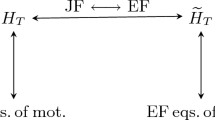Abstract
We investigate two kinds of topological structures (sphere and torus) spanned by the controlled parameters of a driven two-level system’s Hamiltonian and consider the connection between the structures and the system’s dynamics. We discuss the Berry curvature obtained through the dynamical response method, show the certain physical and observable manifolds including the gapped region probed by integrating the Berry curvature and demonstrate the system’s state evolution can be tracked and manipulated by extracting the Berry curvature.





Similar content being viewed by others
Notes
While this paper was in preparation, we became aware of the interesting work published considering the similar Hamiltonian manifold transformation in Ref. [13].
References
M.V. Berry, Quantal phase factors accompanying adiabatic changes. Proc. R. Soc. A 392, 45 (1984)
V. Gritsev, A. Polkovnikov, Dynamical quantum Hall effect in the parameter space. Proc. Natl. Acad. Sci. U.S.A. 109, 6457 (2012)
M.Z. Hasan, C.L. Kane, Topological insulators. Rev. Mod. Phys. 82, 3045 (2010)
S. Sugawa, F. Salces-Carcoba, P.R. Perry, Y.C. Yue, I.B. Spielman, Second Chern number of a quantum-simulated non-Abelian Yang monopole. Science 360, 6396 (2018)
N. Fläschner, B.S. Rem et al., Experimental reconstruction of the Berry curvature in a Floquet Bloch band. Science 352, 6289 (2016)
J. Provost, G. Vallee, Riemannian structure on manifolds of quantum states. Commun. Math. Phys. 76, 289 (1980)
B. Simon, Holonomy, the quantum adiabatic theorem, and Berry’s phase. Phys. Rev. Lett. 51, 2167 (1983)
Z.L. Zhang, M.F. Chen, H.Z. Wu, Z.B. Yang, Quantum simulation of Abelian Wu–Yang monopoles in spin-1/2 systems. Laser Phys. Lett. 14, 045204 (2017)
Z.L. Zhang, M.F. Chen, H.Z. Wu, Z.B. Yang, Quantum simulation of gravitational-like waves in minisuperspace with an artificial qubit. Phys. Rev. D 95, 046010 (2017)
M.D. Schroer, M.H. Kolodrubetzet et al., Measuring a topological transition in an artificial spin-1/2 system. Phys. Rev. Lett. 113, 050402 (2014)
M.V. Berry, J.M. Robbins, Chaotic classical and half-classical adiabatic reactions: geometric magnetism and deterministic friction. Proc. R. Soc. 442, 659 (1993)
P. Roushan, C. Neill et al., Observation of topological transitions in interacting quantum circuits. Nature 515, 241 (2014)
B. Mera, K. Sacha, Y. Omar, Topologically protected quantization of work. Phys. Rev. Lett. 123, 020601 (2019)
D.J. Struik, Lectures on Classical Differential Geometry (Addison-Wesley Pub. Co., Boston, 1961)
C. Song, S.B. Zheng et al., Continuous-variable geometric phase and its manipulation for quantum computation in a superconducting circuit. Nat. Commun. 8, 1061 (2017)
W. Ning, X.J. Huang et al., Deterministic entanglement swapping in a superconducting circuit. Phys. Rev. Lett. 123, 060502 (2019)
Acknowledgements
This work was supported in part by the National Natural Science Foundation of China under Grants Nos. 11875108, 11405031, and the Natural Science Foundation of Fujian Province under Grants 2018J01412.
Author information
Authors and Affiliations
Corresponding author
Appendix A: A concise comparison between two approaches for calculating the Berry curvature
Appendix A: A concise comparison between two approaches for calculating the Berry curvature
In general case, the first Chern number of the ground state manifold is encoded in the gauge-invariant curvature 2-form which can be written as [3]
where \(\textit{B}_{{\theta \phi }}\) is the conventional Berry curvature. For our two-level Hamiltonian, the conventional Berry curvature of the ground state in the gapped region can be expressed as
via the normalized vector component \(\hat{x}={\pmb {x}}/\Vert \pmb {x}\Vert \), which in the sphere and the torus cases are, respectively,
and
We can then calculate the conventional Berry curvatures of the two families via Eq. (A2) to be
and
The corresponding first Chern number of them can be calculated as
and
From Eq. (A7), we notice that the first Chern number is not well defined for \(\Delta _1=\pm \Delta _2\).
We now numerically calculate the Berry curvature using the dynamical method as follows [2]:
and
where \(\hat{\rho }\) is the density matrix of the lower dressed state \(|\psi (t)\rangle =|\psi _g\rangle \) in Eq. (22). Equations (6), (A9) and (A11) show the approach to measure Berry curvature is a leading order approximation, good to the first order in the ramping rate \(\theta _{t}\) (sphere case). However, we notice that the first Chern number in the torus case is no longer a constant number outside the gapped region. The various oscillations in Figs. 3 and 5 noted in the text could not happen in the case of the conventional Berry curvature. From Ref. [2], we know that the method is not that perfect when the ramp velocity is sufficiently large (large deviation from the linear response regime). Therefore, the dynamically non-adiabatic response method we adopt here actually is not equivalent to the conventional one under certain circumstances.
Rights and permissions
About this article
Cite this article
Zhang, ZL., Xu, P. & Yang, ZB. Tracking quantum state evolution by the Berry curvature with a two-level system. Eur. Phys. J. Plus 136, 270 (2021). https://doi.org/10.1140/epjp/s13360-021-01258-6
Received:
Accepted:
Published:
DOI: https://doi.org/10.1140/epjp/s13360-021-01258-6




